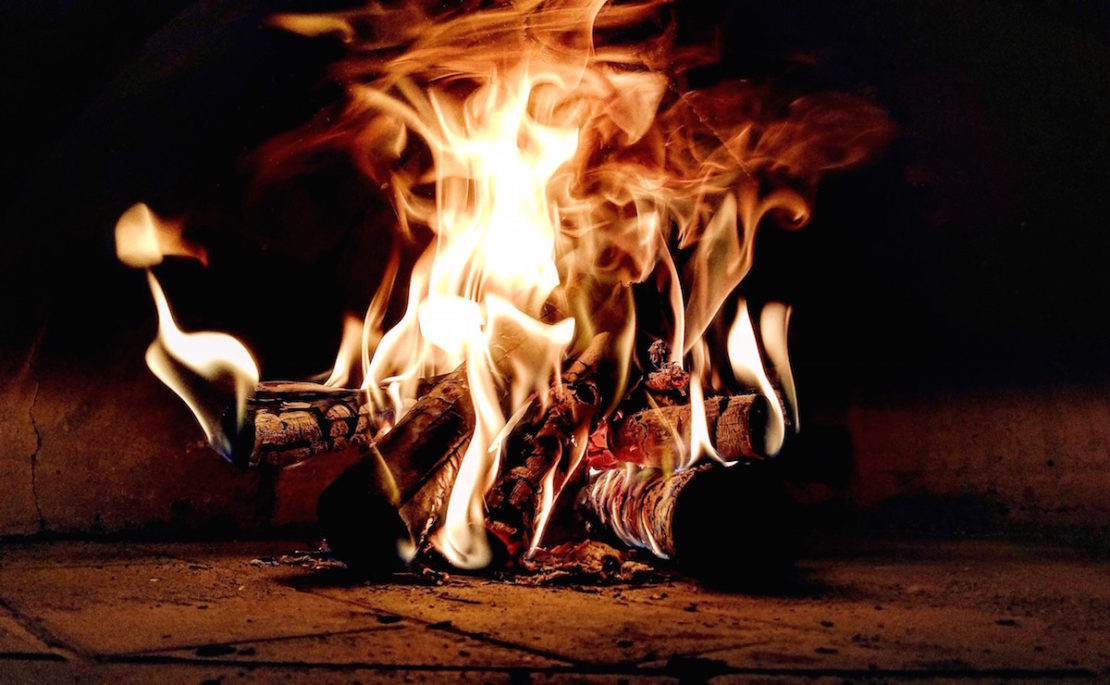
Agni: Understanding the Digestive Fire
Digestive fire or digestive strength is discussed with some frequency across different herbalism and wellness traditions. However, oftentimes we don’t take the time to really break down our understanding of what is meant by digestive fire. Ayurveda has a unique, well-articulated, and beautifully poetic model for understanding digestive wellness. In Ayurveda, one’s agni (digestive fire) is considered the cornerstone of health. In this article, we will explore the ayurvedic teachings on digestive fire—signs of balance, imbalance, and hints as to how to regain and maintain a strong, steadily burning digestive fire.
Agni (digestive fire), prana (life force), and ojas (vitality) are like the three legs of a three-legged stool: each one plays a key role in health—and if one goes, the whole stool topples over. However, in many ways, agni comes first, as without good digestion one cannot have sufficiently circulating prana (life force), nor can one build and maintain good ojas (vigor and vitality).
The Campfire Within
Agni is likened to metabolism and is contained within pitta dosha (Halpern, 2012). It is important to distinguish that agni is not the same thing as pitta dosha, and that everyone, regardless of their ayurvedic constitution, has the capacity for balanced agni. However, those with a strong pitta constitution will tend to have a strong appetite.
You can think of agni like a campfire. You want to keep it burning steady and bright, adding in just the right amount of fuel at the right times. This campfire within plays the role of catabolism and anabolism. It is responsible for breaking our food down into smaller pieces that can then be digested and absorbed. It also ties into whether or not we build healthy tissues (Halpern, 2012).
“On the physical level, digestion is the single most important determinant of good health. This is because the quality of a person’s digestion is directly related to the ability of the body to build quality, healthy tissue” (Halpern, 2012).
If agni is weak, we may build ample tissue, such as adipose (fat) tissue, but it will be of low quality. Or, if agni is low, we may fail to build healthy bone and muscle tissue. If the digestive fire is overly powerful the body will become depleted, literally burning itself up. Either way, if the agni is out of balance, whether the bodily tissues are excessive or deficient, energy levels and overall health and luster will be compromised.

The Qualities of Agni
Agni is hot, light, dry, flowing, sharp, clear, and penetrating (Halpern, 2012). In general, foods, herbs, and lifestyle practices with these qualities will enkindle agni. For instance, foods that are light, spicy, and warming will tend to bolster agni. However, there are exceptions to this. Though agni is dry in nature, some level of water or moisture is needed to fan the agni’s flame, and small amounts of good quality fats, particularly ghee, help spark agni’s flames. Ghee is highly regarded in Ayurveda for its ability to light the digestive fires.
Also, the sour taste, composed of earth, water, and fire is the best taste for strengthening the digestive fire long term. Fire stokes the agni and water provides moisture. The sour taste can be found in lemons, limes, vinegar, pickles, and many chutneys. This is why a squeeze of fresh lemon juice in hot water or a small spoonful of chutney or pickles with a meal helps stimulate the appetite and digestive juices.
Agni: In Balance
Samagni is balanced or perfect digestion. One of my Ayurveda teachers used to nickname this the “unicorn of Ayurveda,” because who truly has perfect digestion?! Perfection aside, even if there are slight irregularities to one’s digestive fire, everyone can get close to healthy, balanced digestion.
What does balanced digestion look like? One simple indicator is the coating on the tongue. If you take a good look at your tongue in the mirror, you will ideally see that it has a very thin coating on it. A thick coating, be it white, yellow, gray, or brown, indicates an accumulation of ama (undigested food matter or metabolic waste). This likely points to one or more of the following conditions in regards to agni: it is running chronically low, it is being overburdened with too much food or too many chemical substances, or it is irregular—sometimes running high and sometimes running low. (More on that in just a moment!)
Signs of a healthy, balanced digestive fire also include good energy levels, clear eyes, a clear complexion, a strong (but not voracious) appetite, and regular bowel movements.
In addition, thinking about agni in broader, metaphorical terms, one can draw lines of connection between physical digestion and mental-emotional digestion. Agni is the ability to digest food, herbs, and other sensory stimuli. The following are signs of balanced agni as outlined by ayurvedic scholar, practitioner, and author Dr. Robert Svoboda (1999):
Signs of Balanced Physical Digestive Fire
- You do not experience discomfort after meals and snacks (absence of gas, acid reflux, or burping that has the taste of food).
- Your stomach does not feel full for an extended time after the meal. Ideally, you want to end your meals feeling about 75-80% full.
- You have regular, daily bowel movements.
- Your appetite is fairly regular from day to day. For example, you typically feel hungry around 9 am, 1 pm, and 6 pm. (It isn’t about these exact times, but rather the sense that you have an appetite and that your hunger occurs at roughly the same times each day.)
Signs of Good Mental Digestion
- You do not experience discomfort after taking in “your desired quantity of sense objects” (Svoboda, 1999, p. 117). For instance, you feel satisfied after watching a movie or reading for an hour or two.
- While processing new information, you are able to assimilate and understand the information and can manage any associated thoughts or emotions; you aren’t left feeling fatigued, jaded, or overwhelmed by the information that you are consuming.
- You are able to retrieve memories, experiences, and learned information as needed. Of course, there is a range of normality in terms of memory. Some people remember names and faces very well and others easily recall numerical facts or lines from movies. The idea, though, is that you have digested the inputs in such a way that you can draw upon them as necessary.
- You sleep soundly and peacefully. Disturbed sleep can be a sign of undigested experiences or mental ama.

Agni: Out of Balance
Now that we have a general understanding of agni and what it looks like when it is balanced, let’s take a look at the ways in which digestive fire can get out of balance—and of course, what to do about it.
We have established that samagni is balanced digestion. So what does digestion out of balance look like? Agni can get out of balance in three main ways. When it runs too low, that is called mandagni. When the fire burns too hot, it is known as tikshnagni or atyagni. Agni that alternates between too high and too low is vishmagni (Halpern, 2012).
Low Digestive Fire
Mandagni is low digestive fire. There are a number of factors that can contribute to this type of situation. First of all, there may be a predisposed tendency. For instance, those with a predominant kapha dosha will tend to have a more subdued appetite and digestive fire. It doesn’t mean that there is anything wrong. However, if one has a chronically low appetite, it is advisable to focus on foods that are light, warming, and relatively small in quantity. In general, spicy, sour, and warming foods will stimulate digestive fire; heavy, moist, and cold foods will dampen the agni.
In addition, overindulgence or illness can cause low digestive fire. If your appetite is low after a day of holiday feasting, this may simply mean that your body is balancing itself out by asking for less food that day. Or, if you have a decreased appetite for a short time during illness, it could mean that your body is focused on fighting off the infection. (Of course, if this occurs for an extended period and there is excessive weight loss, you will want to seek out ways to rebuild appetite, strength, and body tissue.)
On the whole, it is helpful to remember that in Ayurveda, we balance by bringing in the opposite. So, if you experience low digestive fire, focus on foods, herbs, and spices that are light, sharp, and warming, thus sparking the digestive fire. Also, the quantity of food has a tremendous impact on agni. Aiming to eat until about 75% full at each meal can have a remarkably balancing effect on one’s digestive fire (O’Donnell, 2015). The classic texts, such as the Caraka Samhita, place great importance on the proper quantity of food.
“Taken in appropriate quantity, food certainly helps the individual in bringing about strength, complexion, happiness and longevity without disturbing the equilibrium of dhatus and dosas of the body” (Sharma & Dash, 2014, p. 109).

High Digestive Fire
A strong appetite is a sign of good health, but when the agni runs too hot, this is known as tikshnagni. When the digestive fire runs too hot, food will be burned cleanly and completely, so there will not be an accumulation of ama. However, the fuel consumed will not be adequate for proper strength and nourishment. The result over time will be weakness and depletion (Halpern, 2012). This is typically a pitta condition, though the resultant depleted state may be characterized by pitta and or vata doshas.
If the digestive fire is overly hot, one should focus on foods with a cooling energy, typically those with a sweet, bitter, and/or astringent taste. Whole grains, full-fat organic dairy, ghee, nuts, root vegetables, and cooling spices such as fennel, cilantro, and coriander are helpful. Small amounts of dark, leafy greens would also be good to add the bitter taste. However, if there is weight loss and depleted tissues, the individual should make sure they are taking in ample amounts of heavy, nourishing foods—balanced with any necessary digestive spices and herbs.
Variable Digestive Fire
Lastly, variable digestion, or vishmagni, is another common way in which the agni gets out of whack. This imbalance is particularly prevalent in vata individuals. This is because vata is mobile by nature, and this state is characterized by ups and downs in appetite and metabolism. Sometimes the appetite is strong, and sometimes it is weak or absent. Usually, the result is low body weight and accumulation of ama due to incomplete burning of fuel (Halpern, 2012).
For those with variable digestive fire, vata management, particularly developing regular eating habits, will be key. Vata imbalances call for warmth, oil, and regular routine. So, warming, grounding foods, regular meal times, and consistent sleep and activity cycles will likely do wonders in terms of bringing balance to a vacillating agni.
I find the campfire analogy to be a remarkably poetic, helpful, and elegant paradigm in understanding digestive fire. What is the strength of your fire and is the fuel too much, too little, or just right? Rare is the person with perfect digestion. By tuning in to the nuances of our digestive fire and understanding how food, spices, herbs, timing, and other factors play a role, we can learn to better tend our agni—the campfire within.
REFERENCES
Halpern, M. (2012). Principles of ayurvedic medicine. California College of Ayurveda.
O’Donnell, K. (2015). The everyday Ayurveda cookbook: A seasonal guide to eating and living well. Shambhala.
Sharma, R.K., & Dash, B. (2014). Caraka Samhita (Vol. I). (Original work published 400-200 BCE). Chowkhambra Press.
Svoboda, R. (1999). Prakriti: Your ayurvedic constitution. Motilal Banarsidass Publishers.









